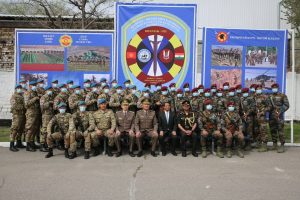Despite the devastating rise in COVID-19 cases in India, on April 16 Kyrgyzstan welcomed a contingent of Indian troops for the 8th India-Kyrgyz Joint Special Forces Exercise “Khanjar.”
The two-week exercise was first initiated in December 2011, in Nahan, India. Broadly, it focuses on high-altitude and mountain operations, in the context of a counterterrorism mission. It remains a modest exercise, little reported or remarked upon. A 2018 report published by the Jamestown Foundation noted that the first iteration included just 20 Kyrgyz service members. Nearly four years later, in 2015, the second iteration took place in Tokmok in Kyrgyzstan (Jamestown pegs the dates to March, citing an Indian Embassy link that’s now dead. An Indian Embassy press release from 2017 states the exercise as having happened in July 2015). The Jamestown Foundation said it included an estimated 100 personnel between the two sides. Khanjar-III took place in 2016, in India, and Khanjar-IV in Kyrgyzstan. Khanjar-V returned to India in 2018, this time at the Counter Insurgency Jungle Warfare School in Vairengte. Presumably, Khanjar-VI took place in Kyrgyzstan in 2019, though there’s no readily accessible reporting on it. In early February 2020, Indian government officials referred to Khanjar-VII as to take place “soon” in India. It’s unclear when it did, if it did proceed as planned.
Nevertheless, the eighth iteration launched in mid-April with a ceremony in Bishkek, attended by the commander of the Kyrgyz National Guards, Colonel Ergeshov Talantbek and Indian Ambassador to Kyrgyzstan Alok A. Dimri. From the available press release, it’s unclear how many troops from either side are taking part but a photo shared by the official Indian Army Facebook page depicted roughly 20 soldiers from each side, donning berets and masks, behind seated officers and dignitaries, unmasked. The post stated that the exercises focuses on “achieving #synergy and #interoperability.”
India shares a long history with Central Asia, most dramatically Babur’s conquest of India, where he founded the Mughal Empire in 1526. In more contemporary times, India has fallen behind Russia and China as influential security partners for the states of Central Asia, but New Delhi has remained engaged, with strategic interests in the region. That is evidenced through increasingly regular bilateral exercises like Khanjar with Kyrgyzstan; a relatively new annual military exercise with Uzbekistan, held for the second time this past March; and the KAZIND and Prabal Dostyk exercises with Kazakhstan (the fourth iteration of KAZIND occurred in October 2019). When it comes to Tajikistan, New Delhi and Dushanbe held a military exercise in 2003, after signing a bilateral defense agreement, but there’s no accessible reporting suggesting subsequent such exercises. (The topic of Tajikistan and India is often carried away by the rumor mill churning over talk of an Indian air base in the country). India, which in 2017 officially joined the Shanghai Cooperation Organization, participated in multinational exercises run by Russia which also included most of the Central Asian countries in 2019; however, in 2020 due to tensions with China, India did not participate in Kavkaz 2020.
Military exercises like the current Khanjar-VIII exercises are a part of regular military-to-military interactions. What’s worth remarking on in this instance is that Kyrgyzstan and India proceeded with the exercises despite the horrific rise in COVID-19 cases in India, an upward trajectory clearly evident by the start of the exercise in mid-April.

































